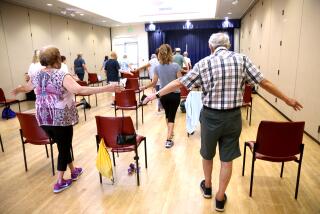MEDICINE GROWING OLDER : Volunteers Undergo Tests to Determine Effects of Aging : Research: Every two years, the subjects pay their own way to Baltimore to help in survey that may unlock the door to biological mysteries of advancing years.
- Share via
BALTIMORE — Richard Sherry began to ponder his own mortality after his father died 20 years ago, and wondered how to extend his own life.
Two years later, Sherry found a way to help get an answer. He enlisted as one of 1,000 volunteers in what has become the longest-running comprehensive study of growing old, the Baltimore Longitudinal Study on Aging.
“We owe it to ourselves,” said Sherry, who, at 57, is a year older than his father when he died. “I’m a great believer in what it is trying to do.”
Sherry comes every two years from Oklahoma City to the Gerontology Research Center at Francis Scott Key Medical Center for 2 1/2 days of tests.
“A great deal of energy has been spent by scientists who have worked in this study for over a quarter of a century to prove that aging is not a disease and does not necessarily end in a disease process,” said James Fozard, the study’s scientific director since 1985. “Many of the things that we used to blame on age . . . are indeed modifiable (by life style) and probably add to the life expectancy and add to the quality of life of people.”
The study, a component of the National Institute on Aging in the National Institutes of Health, was founded in 1958 by Dr. Nathan W. Shock, regarded as the founder of modern research on aging. He started the first NIH section on gerontology in 1941 at Baltimore City Hospital.
“Dr. Shock wanted to measure such things as the rate of aging,” Fozard said. “As it turns out, this hope sort of disintegrated and was replaced by a number of more specific questions.”
The study’s researchers have weighed aging’s effects on more than 1,800 people who were given physical examinations. Tests are done each visit on all of the organ systems, the condition of the blood, muscles, bones, hearing and vision. Electrocardiograms and tests using radiation are given less frequently.
Volunteers also are tested on their memory, reasoning and problem-solving abilities, intelligence and personality, a history of each person’s aging that is used in more than 50 studies under way as part of the overall project.
Among the findings is that “there is no single biological master clock which drives all of the physiological aging that we see,” Fozard said.
Volunteers pay their own way to Baltimore and spend more than two days every 2 1/2 years undergoing as many as 103 medical and behavioral tests. “I know of no other study that makes that kind of demand,” he said. “We ask them for a lifetime” of commitment, and many agree to be autopsied after they die.
The study pays for lodging and meals while volunteers are here, as well as for the tests, which could total $4,000 at a doctor’s office or hospital.
The volunteers range in age from 20 to 97. Sixty-five percent are men, 70% are college educated, and half of those have advanced degrees. Most are middle- or upper-middle-class and only 5% are black.
“In some of the studies the social class definitely makes a difference,” Fozard said. “In that sense, the study may not be as representative” as one with a more varied sample. But “when you compare all types of biological results, these things don’t vary much on social class.”
Scientists who use data from the study say the racial and social structure of the study is one of its weaknesses.
“In an ideal world, we’d have it truly representative of all groups in the United States,” said Dr. Hugh Taylor at the Wilmer Eye Institute at Johns Hopkins Hospital. “But you have to be realistic. There is a variety of people there and everybody is going to die. Everybody gets old.”
Researchers say the study’s history explains its sociological profile.
The first subject, Dr. William Wesley Peter, recruited participants from among family and friends, a practice that continues among volunteers today.
The study has a waiting list of about 1,000 people, and researchers have not made an effort to broaden its base, Fozard said.
Paul Kirby’s grandfather volunteered shortly after the study began. Since then, Kirby, 40, of Glenwood, Md., his father, brother and three sisters became involved. His wife, Pamela, and a sister’s husband also have volunteered.
The involvement of nine members of a single family could help the study determine whether heredity determines aging, Kirby said. “If they can see a trend in different generations of a family, they might find a genetic link.”
That genetic link still has scientists baffled, Fozard said. “We are constantly looking for ways to measure to get a handle on the genetic component of aging. We think there are only a few genes involved with aging, but where they are and what they are is still a mystery.”






